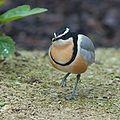- Egyptian Plover
-
Egyptian Plover 
Kaur Wetlands, the Gambia Conservation status Scientific classification Kingdom: Animalia Phylum: Chordata Class: Aves Order: Charadriiformes Family: Pluvianidae Genus: Pluvianus
Vieillot, 1816Species: P. aegyptius Binomial name Pluvianus aegyptius
(Linnaeus, 1758)The Egyptian Plover (Pluvianus aegyptius) is a wader, the only member of the genus Pluvianus. Formerly placed in the pratincole and courser family, Glareolidae, it is now regarded as the sole member of its own monotypic family Pluvianidae.
It is also sometimes referred to as the Crocodile Bird because it is famous for its symbiotic relationship with crocodiles (National Geographic 1986). According to a story dating to Herodotus, the crocodiles lie on the shore with their mouths open, and the plovers fly into the crocodiles' mouths so as to feed on bits of decaying meat that are lodged between the crocodiles' teeth. There is no evidence of this interaction actually occurring in any crocodile species, and it is most likely mythical or allegorical fiction.[2]
The Egyptian Plover is a localised resident in tropical sub-Saharan Africa. It breeds on sandbars in large rivers. Its two or three eggs are not incubated, but are buried in warm sand, temperature control being achieved by the adult sitting on the eggs with a water-soaked belly to cool them. If the adult leaves the nest, it smooths sand over the eggs, though if it is frightened the job may be hasty.
The chicks are precocial, and can run as soon as they are hatched and feed themselves shortly afterwards. The adults cool the chicks in the same way as with the eggs. The chicks may drink water from the adult's belly feathers. The adults bury the chicks in the sand temporarily if danger threatens.
Egyptian Plover is a striking and unmistakable species. The 19–21 cm long adult has a black crown, back, eye-mask and breast band. The rest of the head is white. The remaining upperpart plumage is blue-grey, and the underparts are orange. The longish legs are blue-grey.
In flight, it is even more spectacular, with the black crown and back contrasting with the grey of the upperparts and wings. The flight feathers are brilliant white crossed by a black bar. From below, the flying bird is entirely white, apart from the orange belly and black wing bar. After landing, members of a pair greet each other by raising their wings in an elaborate ceremony that shows off the black and white markings. The sexes are similar, but juveniles are duller and the black marking are intermixed with brown.
This usually very tame bird is found in pairs or small groups near water. It feeds by pecking for insects. The call is a high-pitched krrr-krrr-krrr.
References
- ^ BirdLife International (2004). Pluvianus aegyptius. 2006. IUCN Red List of Threatened Species. IUCN 2006. www.iucnredlist.org. Retrieved on 11 May 2006.
- ^ Adam Britton (2009-09-06). "Croc Blog: Crocodile myths #1 - the curious trochilus". Crocodilian.blogspot.com. http://crocodilian.blogspot.com/2009/09/crocodile-myths-1-curious-trochilus.html. Retrieved 2011-10-20.
- Hayman, Marchant and Prater, Shorebirds ISBN 0-7099-2034-2
- Richford, Andrew S., and Christopher J. Mead (2003). "Pratincoles and Coursers". In Christopher Perrins (Ed.). Firefly Encyclopedia of Birds. Firefly Books. pp. 252–253. ISBN 1-55297-777-3.
Categories:- IUCN Red List least concern species
- Pluvianidae
- Genera of birds
- Higher-level bird taxa restricted to the Afrotropics
- Birds of Africa
- Monotypic bird families
Wikimedia Foundation. 2010.



